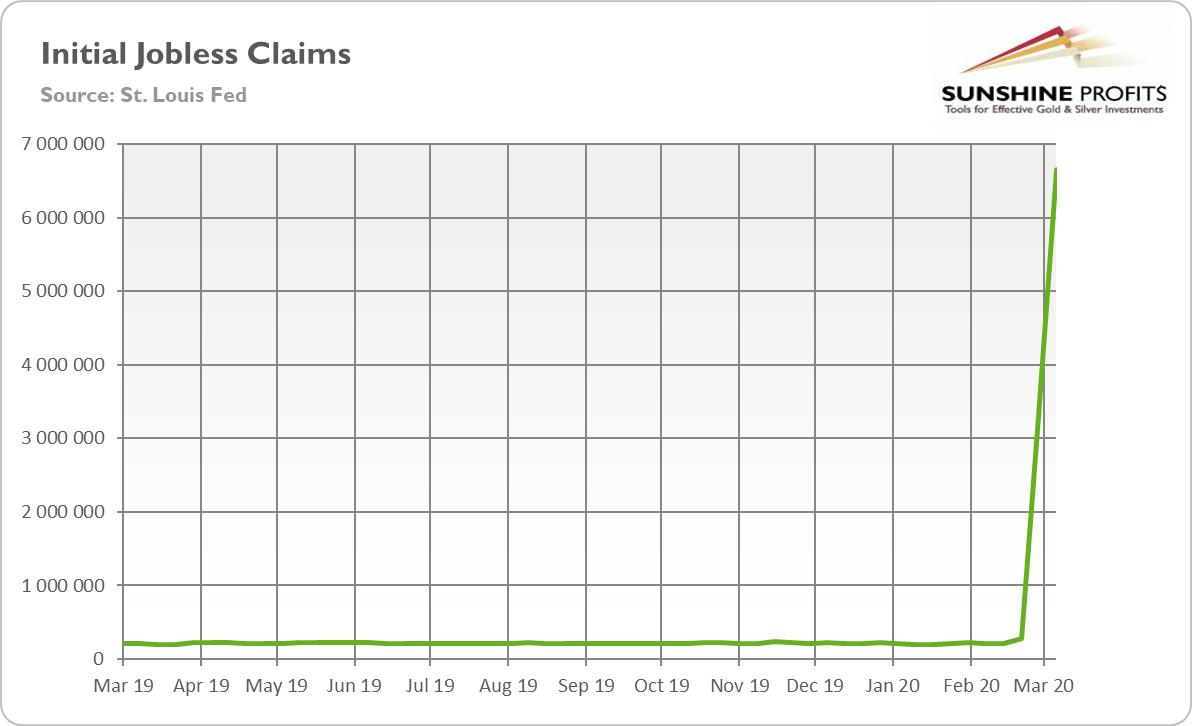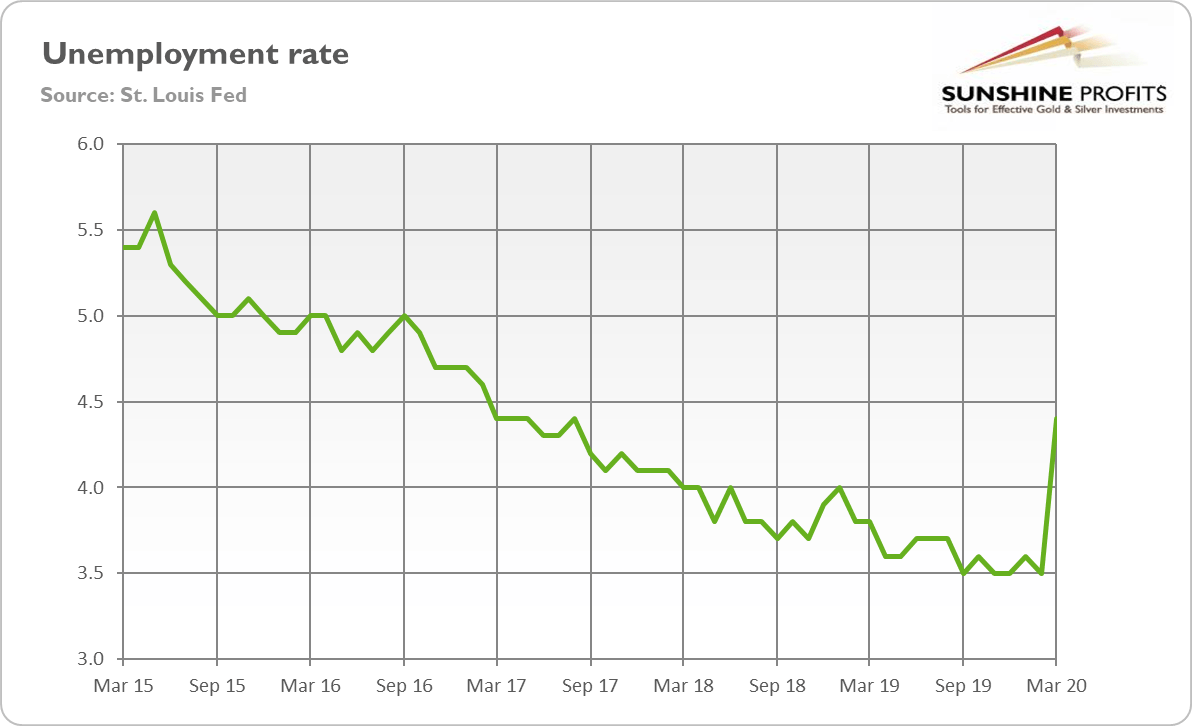10 Million Americans Applied for Unemployment Benefits. Will Gold Save the Day?
In just two weeks of March, around 10 million Americans applied for unemployment benefits. That’s more than during the Great Recession. What does it imply for the US economy and the gold market?
US Labor Market Sinks
In the previous edition of the Fundamental Gold Report, we focused more on the grim US epidemiological situation. Now, let’s analyze the no less gloomy economic crisis! I bet that you have already seen the latest weekly initial claims for unemployment benefits. If not, let’s take a look at the chart below.
Chart 1: US Initial Jobless Claims from March 23, 2019 to March 28, 2020

It shows the number of Americans who applied for unemployment benefits over the last year. The spike at the very right is terrifying, isn’t it? As a reminder, in the previous week, the initial jobless claims rocketed from 282,000 to 3.3 million! Back then, we wrote:
And do you know what is really frightening? The sudden surge in claims is likely just the beginning…
And, indeed, the number has surged even further last week – to 6.6 million! So, we moved from extremely bad to even worse! It means that around 10 million of Americans have already applied for the unemployment benefits due to the coronavirus crisis.
Not surprisingly, the unemployment rate has increased in March. We wrote last time, “brace yourself for the surge in the unemployment rate in March and April!”. And this is exactly what happened. The unemployment rate has risen from 3.5 in February to 4.4 percent in March, as the chart below shows.
Chart 2: US unemployment rate from March 2015 to March 2020.

Surely, it did not surge, but investors should remember that the Bureau of Labor Statistics’ Employment Situation Report is based on the total number of payroll records for employees who were active on a company’s payroll through the 12th of the month, just before the pandemic and shutdown started to damage the economy. It means that the reported number does not fully reflect the most recent impact of the COVID-19 pandemic on the US labor market.
The situation is actually much worse than the official data suggests. See the nonfarm payrolls. According to the report, the US lost only 701,000 jobs in March, although the spike in claims for unemployment benefits shows that around 10 million jobs were actually lost! It suggests that the unemployment rate in reality surged to around 10 percent or more.
Implications for the US Economy
The implication is clear. The coronavirus crisis will be worse than the Great Recession and possibly also than the Great Depression. In just the past two weeks, initial claims have exceeded the peak number of people who collected benefits during the global financial crisis of 2007-2009!
The surge in the unemployment means lower consumer spending, which will negatively affect the GDP growth. Higher unemployment also means lower tax revenue for the government, while higher expenditures on the benefits and social protection. So, brace yourself for the deep recession in Q2 and a surge in the fiscal deficit – both factors should be positive for the gold prices.
OK, we already know that a huge recession is on the horizon. But then the economy will quickly recover, right? Well, not necessarily. We mean, of course, the economy will one day rebound, there is no doubt about it. But you can forget about a quick V-shaped recovery. Why? This is simple: the current crisis is not a one-time negative supply shock like an earthquake or an increase in oil prices. The virus will stay with us until either natural immunity amply develops, or the vaccine arrives, or it the epidemics burns itself out. It means that even if the economic shutdown is relaxed, the social distancing will not disappear. The fear will remain for some time, as well as many restrictions. For example, scientists at Imperial College London are warning containment measures may have to stay in place for several months! People will neither travel, nor attend crowded events for a while.
Another issue is that it is easy to become unemployed, but much harder to get work. Some people will lose their skills, other will drop from the labor force for good. In other words, with so many people out of job, don’t count on a fast recovery. Similarly, the company’s closure or bankruptcy is not easily reversible. There is always a hysteresis: shocks have not only short-term effects, but also permanent repercussions. And do not forget about the expansion of easy monetary and fiscal policies – they can cushion the initial hit, but they will not prevent the deep crisis (we will elaborate on this in the future) and they will hamper the recovery. Last but not least, the longer the economic shutdown lasts, the higher the risk of the massive bankruptcies and financial crisis – which would be a final nail in the coffin of the US economy (we will elaborate on this as well in the future).
Implications for Gold
From the fundamental point of view, the current crisis is positive for the gold prices. Actually, when you look across the different asset class, you will see that the gold’s performance was relatively the best (compared to the equities or oil). It would be even better if it was not for the strong dollar and the panic sales of gold in the hunt for liquidity. However, this downward pressure should end one day, while investors would acknowledge unpleasant consequences of the economic recession, ultra-easy monetary policy and soaring federal debt. We know that this crisis is unique, but we would be very surprised if gold would not eventually benefit from it, just as did in the aftermath of the Lehman Brothers’ collapse.
Want free follow-ups to the above article and details not available to 99%+ investors? Sign up to our free newsletter today!
All essays, research and information found above represent analyses and opinions of Przemyslaw Radomski, CFA and Sunshine Profits' employees and associates only. As such, it may prove wrong and be a subject to change without notice. Opinions and analyses were based on data available to authors of respective essays at the time of writing. Although the information provided above is based on careful research and sources that are believed to be accurate, Przemyslaw Radomski, CFA and his associates do not guarantee the accuracy or thoroughness of the data or information reported. The opinions published above are neither an offer nor a recommendation to purchase or sell any securities. Mr. Radomski is not a Registered Securities Advisor. By reading Przemyslaw Radomski's, CFA reports you fully agree that he will not be held responsible or liable for any decisions you make regarding any information provided in these reports. Investing, trading and speculation in any financial markets may involve high risk of loss. Przemyslaw Radomski, CFA, Sunshine Profits' employees and affiliates as well as members of their families may have a short or long position in any securities, including those mentioned in any of the reports or essays, and may make additional purchases and/or sales of those securities without notice.
Recommended Content
Editors’ Picks
EUR/USD retreats below 1.0700 after US GDP data

EUR/USD came under modest bearish pressure and retreated below 1.0700. Although the US data showed that the economy grew at a softer pace than expected in Q1, strong inflation-related details provided a boost to the USD.
GBP/USD declines below 1.2500 as USD rebounds

GBP/USD declined below 1.2500 and erased the majority of its daily gains with the immediate reaction to the US GDP report. The US economy expanded at a softer pace than expected in Q1 but the price deflator jumped to 3.4% from 1.8%.
Gold drops below $2,320 as US yields shoot higher

Gold lost its traction and turned negative on the day below $2,320 in the American session on Thursday. The benchmark 10-year US Treasury bond yield is up more than 1% on the day above 4.7% after US GDP report, weighing on XAU/USD.
XRP extends its decline, crypto experts comment on Ripple stablecoin and benefits for XRP Ledger

Ripple extends decline to $0.52 on Thursday, wipes out weekly gains. Crypto expert asks Ripple CTO how the stablecoin will benefit the XRP Ledger and native token XRP.
After the US close, it’s the Tokyo CPI

After the US close, it’s the Tokyo CPI, a reliable indicator of the national number and then the BoJ policy announcement. Tokyo CPI ex food and energy in Japan was a rise to 2.90% in March from 2.50%.